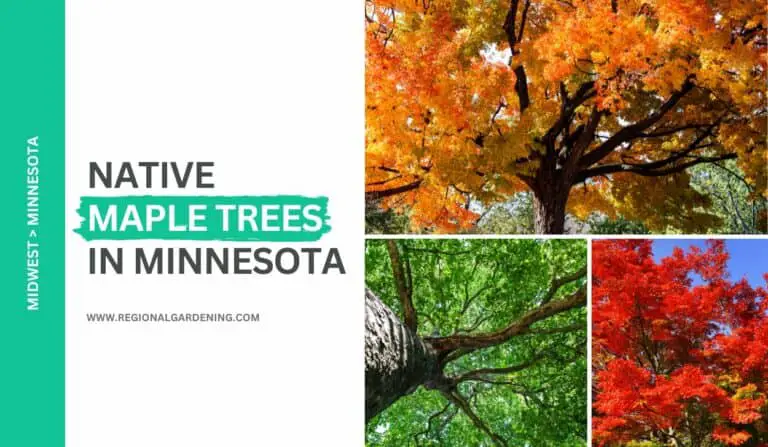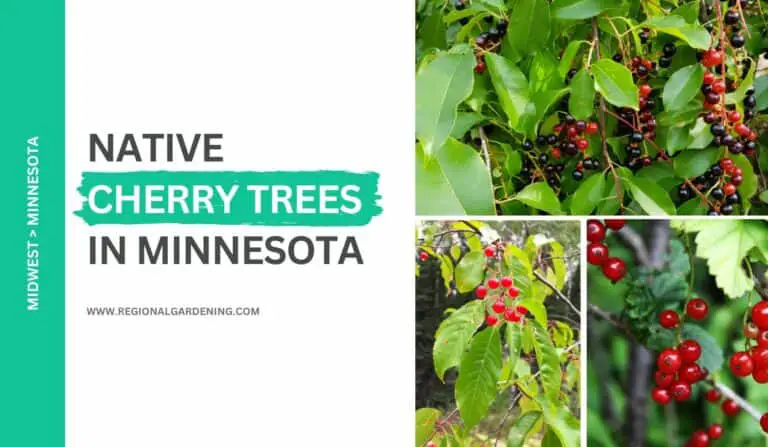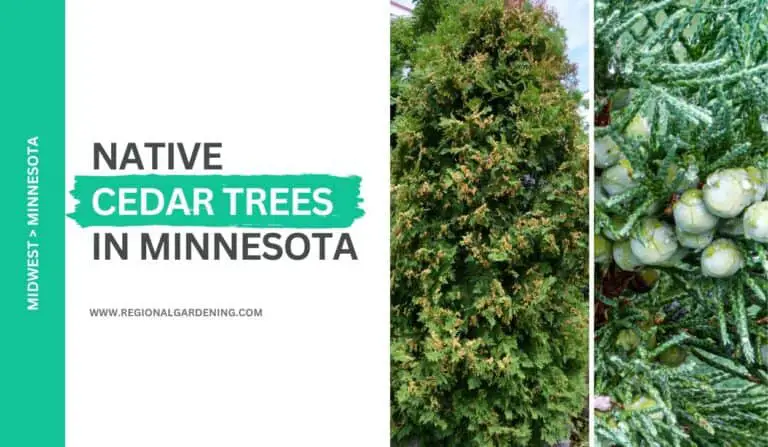7 Native Oak Trees In Wisconsin (Photos & Identification)
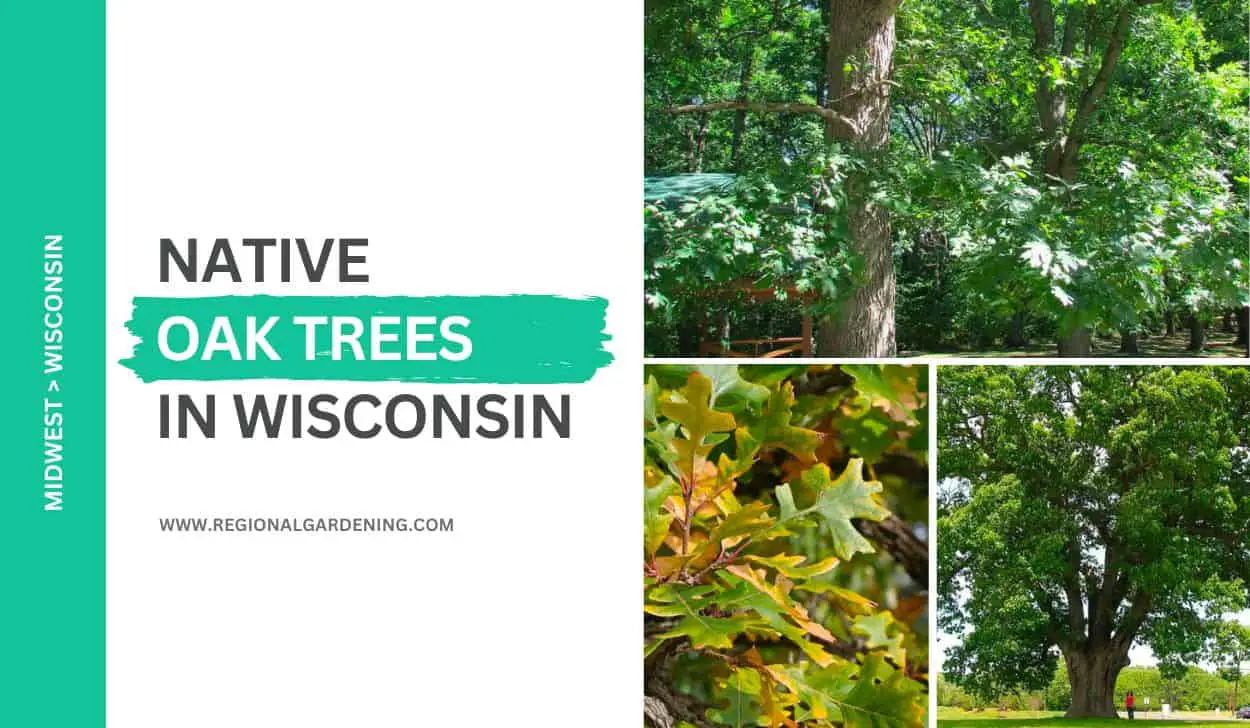
Ohio is blessed with a diverse array of oak trees, whether they have flourished naturally within its borders or have been intentionally introduced from other regions. These majestic trees not only enhance the state’s aesthetic appeal but also play a vital role in maintaining its ecological balance.
In this article, I will walk you through the 7 most commonly found native oak trees in Wisconsin. Each species possesses its own distinct characteristics and allure. The White Oak boasts robust trunks capable of withstanding the test of time, while the Chinkapin Oak dazzles with its mighty presence.
So, let’s get started.
1. Black Oak
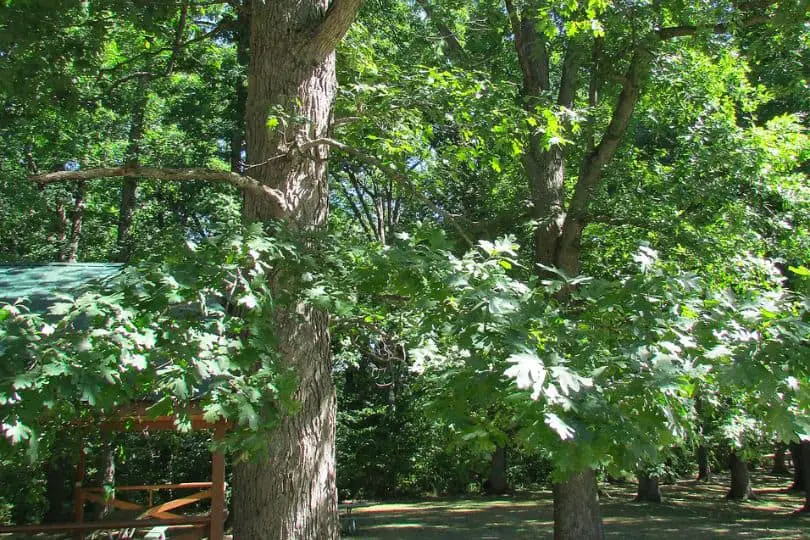
- Common Name: Black Oak
- Scientific Name: Quercus velutina
- Mature Height: 50 to 75 feet
- Native/Non-Native: Native
- Flowers/Cones: Acorns
- Uses: Construction, interior finish, furniture, pulp, ties, fuel, tannin, yellow dye
One of the most commonly found oak trees in Wisconsin, the Black Oak tree is a majestic tree that can grow up to 75 feet tall and 3 feet in diameter! A huge Black Oak tree’s trunk can be clear for up to 20 feet, and its crown can be vast and irregularly formed.
This tree has deep furrows and rough, broken ridges and has smooth and dark brown bark when young and thick and black bark when older. The inner bark of the Black Oak is brilliant yellow and bitter due to the presence of tannic acid.
The Black Oak’s leaves are alternate, which means they grow on opposite sides of the stem. They can reach 8 inches in length and 5 inches in width and are lobed halfway to the midrib. They have bristle-tipped tips and a top surface that is thick, dark green, and lustrous. The lower surface is whitish and covered in down, with rusty brown hairs visible in the vein forks.
Black Oak fruits are light brown acorns that mature during the second season. They can grow to be about an inch long and spherical. The nut is surrounded by a narrow, dark brown, scaly cup that covers 3/4 of it. The kernel is yellow in color and exceedingly bitter.
These trees can be found throughout the southern half of the state on arid uplands, gravel slopes, and ridges. Black oak wood is sturdy, weighty, and powerful. It has a coarse grain and is not particularly robust, easily checked.
Black Oak’s heartwood is a vivid reddish-brown with a thin outer sapwood. Black oak wood is mostly used in building, interior finishing, furniture, pulp, ties, and fuel. The bark of the Black Oak can also be used to make tannin and yellow dye.
While the Black Oak is a magnificent tree, it is prone to oak wilt, so it is critical to properly care for these trees after they are planted.
2. Bur Oak
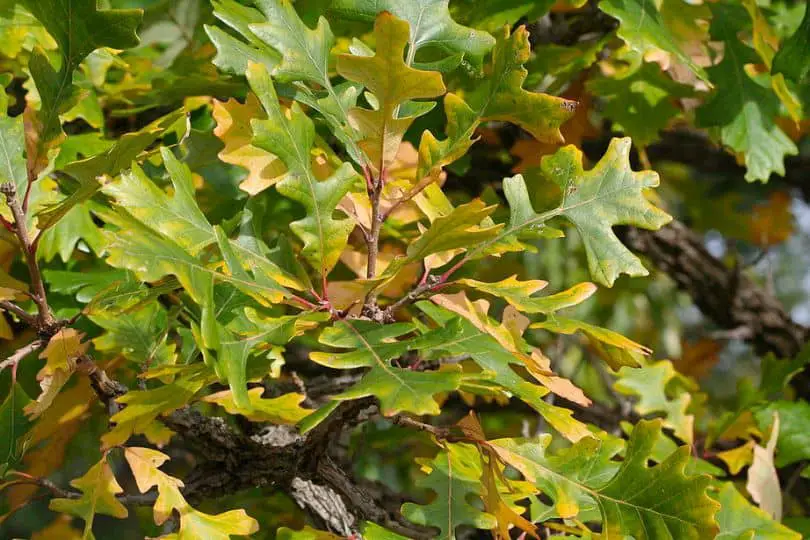
- Common Name: Bur Oak
- Scientific Name: Quercus macrocarpa
- Mature Height: 80 feet or more
- Native/Non-Native: Native
- Flowers/Cones: Acorn enclosed in burr-like cap
- Uses: Similar to white oak
The bur oak trees are the second most commonly found oak trees in Wisconsin after Black Oak. It is a magnificent tree that can reach heights of 80 feet or more. This majestic tree, located throughout the state, can live for hundreds of years. It is indigenous to the area and represents strength, resilience, and beauty.
Bur oak bark is thick and heavily furrowed, with uneven, platelike scales ranging in color from dark gray to black. Smaller branches are decorated with ridges and corky wings, lending them a nasty aspect. Bur oak leaves are huge, measuring 6 to 10 inches long and up to 6 inches wide, with a dark green tint on the upper side and a paler color and hairy texture on the underside. The leaves are crowded at the tips of the twigs and seem similar to white oak leaves, but with wavy notches on the middle and top regions and a pair of deep indentations near the base.
The acorn is the fruit of the bur oak, and it is enclosed in a burr-like cap that is fringed and ovoid in shape. The acorn’s diameter can reach 1 inch or more, and there can be differences in size and degree of encasing. The seed is bitter, and it matures in only one season.
Bur oak trees are commonly found in open places, where they can have a broad crown of heavy, spreading branches and a relatively short trunk. They are quite resilient and may survive in harsh environments, though their height is usually limited to roughly 25 feet in such cases.
Bur oak wood is heavy, robust, strong, resilient, and durable, with a deep brown heartwood akin to that of white oak. As a result, it serves many of the same functions.
3. White Oak
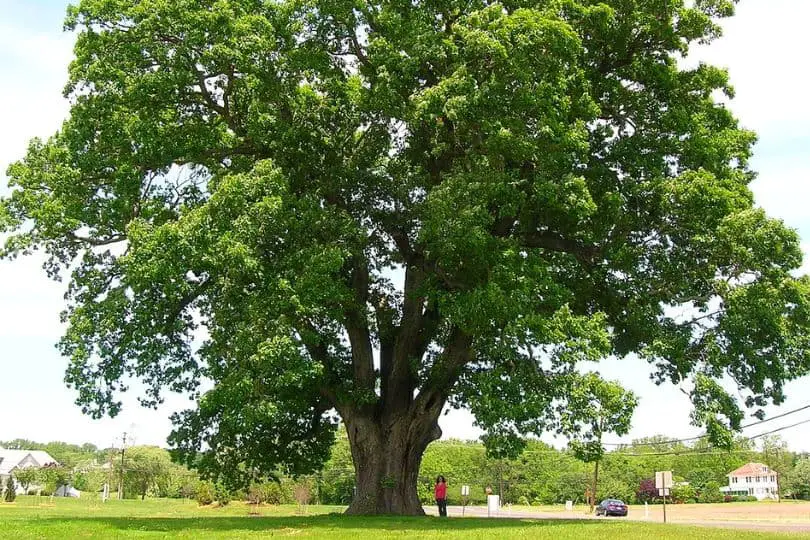
- Common Name: White Oak
- Scientific Name: Quercus alba
- Mature Height: 60 to 100 feet
- Native/Non-Native: Native
- Flowers/Cones: Acorns
- Uses: Heavy construction, railroad ties, interior finishes, furniture, and fuel.
One of the tallest oak trees in Wisconsin, the white oak tree is a strong tree endemic to much of North America, including the southern half of the United States. White oak trees can reach heights of 100 feet and have trunk diameters of up to 3 feet. Their bark is scaly and pale gray, but not deeply fissured.
This oak tree species has alternating leaves that are 5 to 9 inches long and roughly half as wide. They are deeply divided into 5 to 9 lobes and turn light green on top and much paler on the bottom. Some White Oak leaves even stay on the tree throughout the winter.
The acorn is one of the most distinctive features of White Oak. Acorns from White Oak are roughly 3/4 to 1 inch long and light brown in hue. They mature in the first year while contained in a cap. After ripening, the plant germinates and sends down a long, deep top root before winter.
White oak is typically found on superior soils in the state’s southern portion. Its wood is light brown, robust, and long-lasting, making it one of the best woods for heavy construction. Railroad ties, interior finishes, furnishings, and fuel are all made from white oak.
4. Swamp White Oak

- Common Name: Swamp White Oak
- Scientific Name: Quercus bicolor
- Mature Height: 65 to 80 feet
- Native/Non-Native: Native
- Flowers/Cones: Acorns
- Uses: Wood for commercial purposes
Swamp White Oak is a natural tree species found in the southern United States. This tree thrives in damp, fertile soil near rivers and swamps. It can grow to be 65 to 80 feet tall and 2 to 3 feet wide, with an open and round-topped crown.
The Swamp White Oak has a characteristic bark that is thick, deeply and irregularly separated into broad ridges by fractures. The bark on the higher branches is often rough and peels off, giving it a distinct appearance.
The Swamp White Oak leaves are especially impressive, measuring 5 to 6 inches long and 2 to 4 inches wide. They have a broad pear-shaped centre and a wedge-shaped base and are frequently packed at the ends of the branches. The leaves have wavy and indented borders and are dark green and lustrous on top, while grey and fuzzy on the bottom.
The Swamp White Oak bears acorns that are about 1 inch long and 34 inches wide. The fruit is contained in a thick-walled cup for about one-third of its length and grows in pairs on 2 to 4 inch tall slender and dark brown stalks. The fruit matures in a single season, making it an excellent food source for wildlife.
Because of its light brown hue, hardness, strength, toughness, and durability, Swamp White Oak wood is commercially valued. It possesses qualities similar to white oak and bur oak and is utilized in similar ways.
5. Red Oak
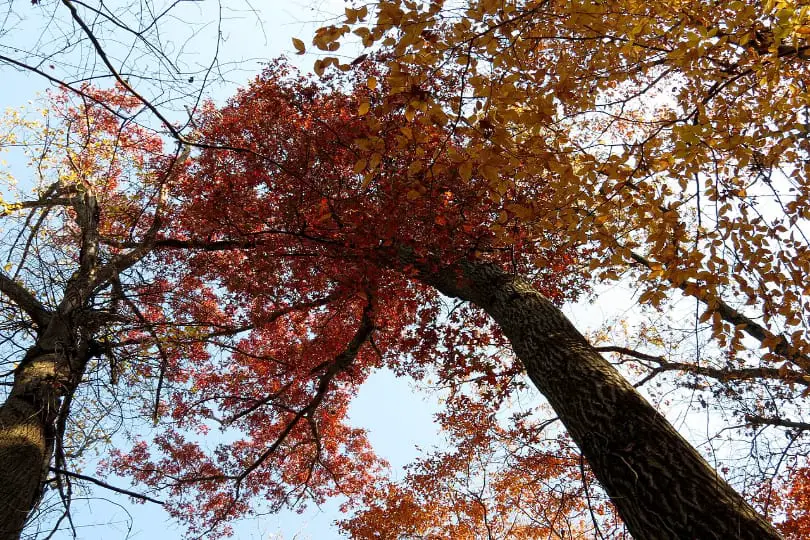
- Common Name: Red Oak
- Scientific Name: Quercus rubra
- Mature Height: 70 to 90 feet
- Native / Non-Native: Native
- Flowers / Cones: Bitter acorn fruit
- Uses: Construction, furniture, fuel
The majestic Red Oaks are among the tallest oak trees in Wisconsin along with the white oak. It is a tall, straight tree with a narrow crown that can reach heights of 70 to 90 feet. It has a diameter of 2 to 3 feet, making it a strong tree that can withstand the elements.
The leaves are alternating and can reach lengths of 5 to 9 inches and widths of 4 to 6 inches. They are separated into 7–9 lobes, each of which extends halfway to the mid-rib. Each lobe is coarsely serrated and bristle-tipped, and the hue is dull green on top and paler on the bottom. The buds are pointy and thick.
The bark of the Red Oak is smooth and dark gray to dark brown on young stems. However, as the tree ages, the bark thickens and turns gray to brown. Because it is so thick, it is divided into regular, flat, smooth-surfaced, vertical plates.
The Red Oak tree’s fruit is a huge, bitter acorn that matures in the second year. The length spans from 1 to 1.5 inches, with a blunt top and a flat base. It is encased in a shallow, dark brown cup with a velvety interior.
The bright, reddish-brown heartwood of the Red Oak tree is well known. It is tough, robust, and coarse, making it ideal for building and furniture. It is also an excellent source of fuel. The best Red Oak logs are cut into veneer and utilized in house and furniture finishes.
6. Northern Pin Oak
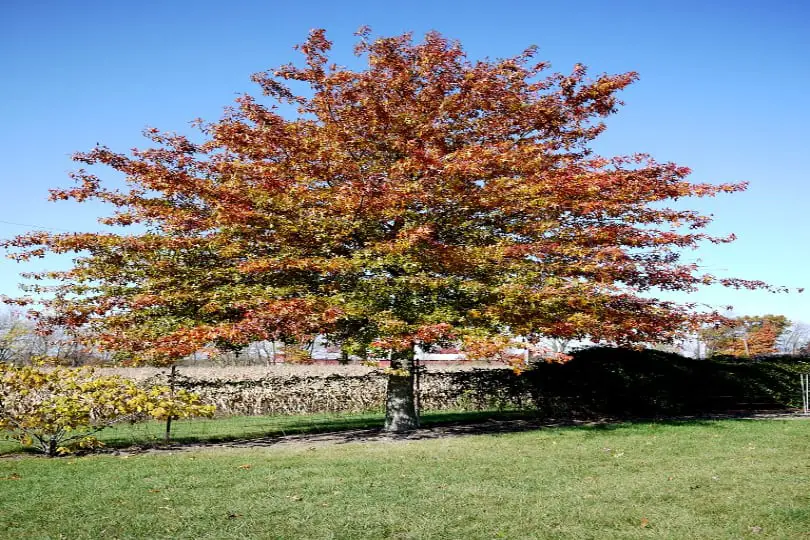
- Common Name: Northern Pin Oak
- Scientific Name: Quercus ellipsoidalis
- Mature Height: Up to 50 feet
- Native/Non-Native: Native
- Flowers/Cones: Acorns
- Uses: Fuel, posts, railroad ties, hardwood pulp
Northern Pin Oak, sometimes known as Hills or Jack Oak, is a lovely tree found throughout Wisconsin. This deciduous tree can reach heights of up to 50 feet and has a diameter of up to 2 feet. The trunk is small, with numerous forked branches.
Northern Pin Oak bark is similar to Scarlet Oak bark, however the inner bark has a pale yellow tint. This tree’s leaves resemble those of the Scarlet Oak, although they are not as lustrous and contain five to seven lobes. The leaves turn a gorgeous shade of golden or pale brown in late fall, and they are sometimes blotched with purple.
The Northern Pin Oak’s fruit is called an acorn, and it takes two seasons to develop. The acorn is encased in a cap for 1/3 to 1/2 of its length, which progressively tapers at the base.
Northern Pin Oak can be found throughout the state, primarily on sandy, low-fertility soils. It used to grow alongside pines, but fires have killed most of the pines. However, because the oak can reproduce from sprouts, there are many acres in Wisconsin with pine-capable soil that are producing Northern Pin Oak instead.
Northern Pin Oak wood is similar to Red Oak wood and is used for fuel, posts, railroad ties, and hardwood pulp.
7. Chinkapin Oak
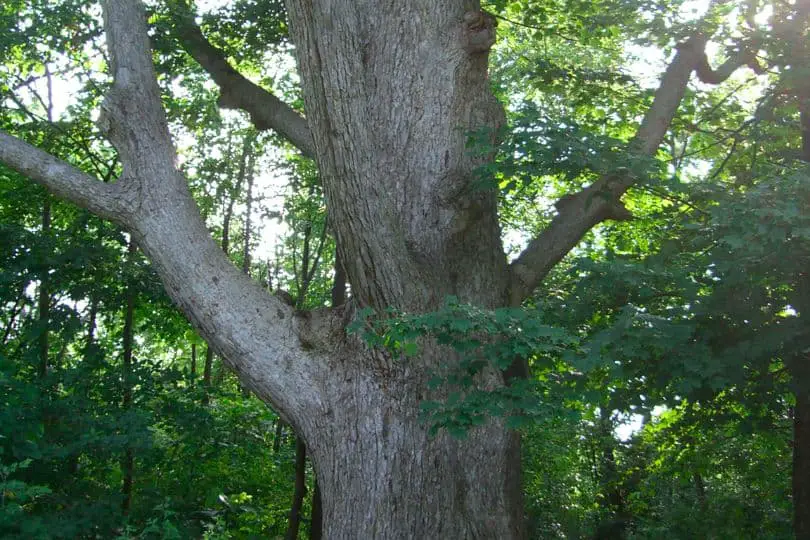
- Common Name: Chinkapin Oak
- Scientific Name: Quercus muehlenbergii
- Mature Height: Reaches 80 to 100 feet in height and 3 to 4 feet in diameter
- Native/Non-Native: Native
- Flowers/Cones: Acorns grow singly or in pairs, with short heavy stalks, the nut covered for half its length by the thin cup.
- Uses: Seed is sweet and edible, and the wood is similar to white oak.
One of the least common native oak trees in Wisconsin, the Chinkapin Oak, is a massive tree that may grow up to 100 feet tall and 4 feet thick. Typically, the bark is thin, pale gray, and scaly.
The leaves are 4 to 7 inches long, clustered on the ends of the branches, and contain sharp, incurving, or broad circular teeth. The upper surface is pale and covered with fine short hairs, while the bottom is pale and covered with fine short hairs.
The Chinkapin Oak’s fruit is the acorn, which grows single or in pairs on strong stalks. A thin cup covers half of the nut’s length. Because the seed is pleasant and edible, it is a vital food source for animals such as squirrels, deer, and turkeys.
This tree is endemic to Wisconsin’s southern areas as well as other parts of the United States. It can be found growing on limestone hills, fertile bottom areas, and rocky stream banks. While it was originally abundant in numerous southwestern counties, it now grows rarely in these areas and should be favored where it is found.
The quality of Chinkapin Oak wood is comparable to that of white oak, except it has more knots. The wood is used to make furniture, flooring, and barrels due to its strength and durability.
Sources
- Native Ash Trees In Wisconsin
- Native Aspen Trees In Wisconsin
- Native Pine Trees In Wisconsin
- Native Spruce Trees In Wisconsin
- Native Cedar Trees In Wisconsin
- Native Birch Trees In Wisconsin
- Native Maple Trees In Wisconsin
- Native Elm Trees In Wisconsin
- Native Hickory Trees In Wisconsin
- Native Locust Trees In Wisconsin
- Native Cherry Trees In Wisconsin
- Native Nut Trees In Wisconsin
Native Oak Trees In Wisconsin – Sources
The Regional Gardening team makes sure that the information in our articles is accurate by only using sources that are known to be trustworthy. Some of these sources are peer-reviewed journals from government agencies, well-known universities, and scientific research organizations.
- Tree Planting, Wisconsin Department Of Natural Resources
- Trees Identification, Wisconsin Department Of Natural Resources
- Forest Trees Of Wisconsin, Wisconsin Department Of Natural Resources
- Trees of Wisconsin Field Guide, Book by Stan Tekiela


